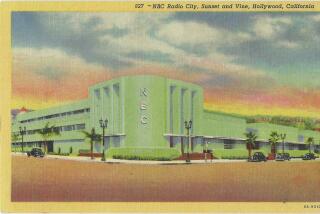JOHNNY CARSON’S BELLY-UP KNAT: MORE TO COME?
ALBUQUERQUE — What happened to Channel 23? When KNAT-TV, an independent television station here, went off the air at the end of April, few people outside of New Mexico noticed.
Like scores of other independent stations around the country--stations not affiliated with any of the Big Three commercial networks--KNAT had a relatively weak signal and an undistinguished program schedule that had attracted relatively few viewers and fewer advertisers in its brief three-year life.
Then, a TV industry trade paper reported who owned the station: Johnny Carson, Neil Simon, Paul Anka, David Letterman, Joan Rivers and others.
With such well-known names attached to it, the demise of tiny KNAT attracted attention throughout the television industry, and the station has become practically a textbook example of what can go wrong in the volatile business world of local TV.
At a time when some independent TV stations are commanding astronomical sales prices and revenues surpassing network-affiliated stations, KNAT failed miserably. Its celebrity owners have lost an estimated $8 million in a business that, until now, has been thought to be just about the closest thing there is to a guaranteed moneymaker.
Behind KNAT’s failure are all too common mistakes, miscalculations and missed opportunities that, TV industry officials say, promise to force other independent stations like KNAT out of business in the coming months and years. Industry executives say that a massive shakeout in independent TV is starting, and it already has begun on the arid high plains of New Mexico.
“There are going to be more independents going under or broke in the next five years than in the history of independent television,” Greg Nathanson, vice president for programming of Los Angeles-based Golden West Television, told a recent luncheon audience of the Hollywood Radio and Television Society.
Across the country, the number of independent stations has grown from 121 in 1980 to more than 214 today. The Washington-based Assn. of Independent Television Stations estimates that another 25 may go on the air within the next 12 months. The association expects about 300 independent stations on the air by 1990.
Like Albuquerque’s darkened KNAT, 181 of these new stations are on the traditionally less desirable UHF (ultra-high frequency, Channels 14-83) television frequencies. UHF stations have neither the signal quality nor the extended coverage area of VHF (very high frequency, Channels 2-13) stations.
Many of these UHF stations have profited from a 20-year-old federal regulation requiring local cable systems to carry signals of smaller over-the-air stations. Two weeks ago, however, a federal court declared the regulation unconstitutional.
In the very largest cities--most notably in Los Angeles where VHF independent KTLA recently sold for more than half a billion dollars--independent TV stations remain hot entertainment properties.
The ratings of such major independents often rival and sometimes surpass network affiliates. This has contributed to the growth of independent TV stations in smaller cities that, traditionally, have been unable to support more than three network stations and, perhaps, one independent.
In Atlanta, for example, there are now four independents on the air where there used to be only Ted Turner’s fabulously successful WTBS superstation. In Boston, the number of independents has doubled from two to four. Dallas now has five non-network stations, and Houston has four. Tiny Asheville, N.C., which a year ago had no independents, is about to see three go on the air.
Concurrent with this boom, have been tremendous price increases for what stations pay to Hollywood studios and syndication companies for their programming. In the last decade, all independent station program costs have risen from just about $75 million to more than $637 million.
But, outside of the very largest cities, the ratings often aren’t so hot. Advertising rates haven’t kept pace with the cost of programming and since advertising is the lifeblood of commercial TV, the failure of revenues to keep up with the rising number of stations and higher program prices creates an equation for disaster.
“You’re going to find a lot of these new independent stations go bust. Advertisers look at the ratings and say, ‘Well, this is all I’m going to pay you,’ ” insisted Max Sklower, vice president and general manager of ABC-affiliated KOAT-TV.
That’s what happened to KNAT and what industry officials say is about to happen everywhere else.
If more independent stations fail in the coming years, the financial impact on Hollywood studios and syndication companies could be devastating, possibly ending the prolonged boom in the syndication business that has become a financial mainstay to producers and distribution companies.
Hollywood has grown financially fat as these new independent stations aggressively compete for the rights to air reruns of hit network series such as “Three’s Company,” “MASH” and “Magnum P.I.” Last year, for example, MCA-TV (Universal) sold “Magnum” for $120,000 an episode in Los Angeles and $98,000 a program in New York. According to industry reports, sales of “The A-Team” have already topped the records set by “Magnum.”
Such programs are commanding as much as $7,000 an episode in Albuquerque, where commercial time often can be bought for less than $100 a minute.
“I think we’ll see a lot of KNATs around the country go dark,” said Jerry Danziger, general manager of KOB-TV, Albuquerque’s 31-year-old NBC-affiliated station. “The advertiser isn’t going to pay more for commercials just because you paid more for programming. They’re still going to buy by the numbers (ratings).”
The specifics of KNAT’s demise are disputed.
In the weeks since the station went off the air, charges and countercharges have flown like tumbleweeds across desert highways. Local broadcast executives have made the unproved claim that syndication companies, fearful of offending Carson, allowed the station to go for months--perhaps as long as a year in some instances--without paying its programming bills.
In turn, persons associated with the KNAT have made equally unsupported claims that local broadcasters informally conspired to keep programming and advertising rates low and forced the station out of the market.
Rusty Durante, vice president and general manager of independent KVVU Channel 5 in Las Vegas, was instrumental in getting KNAT on the air. He oversaw the station’s first year of operations.
“It’s a sad story. . . . KNAT had a lot of bad luck, and there was really nothing anyone could do about it,” Durante said in an interview in his Las Vegas office.
In 1982, when the Carson interests, acquired the Albuquerque station, the talk-show host also owned Durante’s Nevada station, one of the most successful independents in the country. Last year, Carson sold KVVU for more than $27 million.
Hoping to re-create the Las Vegas success in Albuquerque, the Carson interests moved swiftly and aggressively into New Mexico. Local advertisers were feted at a Carson-hosted gala in Las Vegas. Early on, Carson appeared in KNAT promotional ads. That sent Jerry Danziger complaining to NBC, which saw to it that Carson’s on-air appearances for his station ended.
That hurt KNAT, according to one local advertiser, who said that the celebrity names on the ownership list of the station led many in Albuquerque to believe that the Carson station would inject a bit of Hollywood glitz into the relatively sleepy community.
“I think that probably the local people expected with that ownership a higher degree of sophistication and and visibility,” said advertising executive Dick McKee, who estimates that he spends more than $1 million a year with Albuquerque TV stations.
The programming costs skyrocketed as four independents went on the air in Albuquerque in a two years. First, KGSW-TV started up in 1981. Carson’s station followed in 1982. Then, in nearby Santa Fe, KNMZ-TV debuted on Channel 2 and KCHF-TV began operating on Channel 11.
The heated competition among the stations drove program prices up sixfold, local broadcasters claim, while in the same time, local advertising revenues only doubled from about $17 million shared by three network-affiliated stations to about $35 million shared by seven affiliates and independents.
“Programming costs have risen astronomically in this market,” said Shirli Mix, general sales manager for independent KGSW. “It wasn’t just KNAT. When KMNZ came into Santa Fe, they paid the highest price for any program that’s ever been paid here.”
Despite the increase in viewing choices, 70% to 80% of the audience and the advertising remained with the affiliates.
“Book after rating book, (the public) has not seemed to cotton to these independent stations,” said KOAT’s Sklower, whose local evening news, for example, has a phenomenal 41% share of the audience. “They’re all reruns, and I guess the public never felt compelled to watch the stations like they would if one were a network station.”
That sentiment was echoed by advertiser McKee: “There was no real reason for watching the station. UHF television, to me, is alternative programming. If there’s no alternative, then there’s nothing to watch. . . . If I don’t watch them as a viewer, then I begin to question their value as an advertiser.”
Perhaps potential buyers of KNAT should question the station’s value as an investment. According to Carson’s lawyer, Henry Bushkin, KNAT’s owners are hoping to sell it for about $3 million, slightly more than they paid in 1982. According to local broadcasters, however, the top offer so far has been only about $1.5 million.
More to Read
The biggest entertainment stories
Get our big stories about Hollywood, film, television, music, arts, culture and more right in your inbox as soon as they publish.
You may occasionally receive promotional content from the Los Angeles Times.










